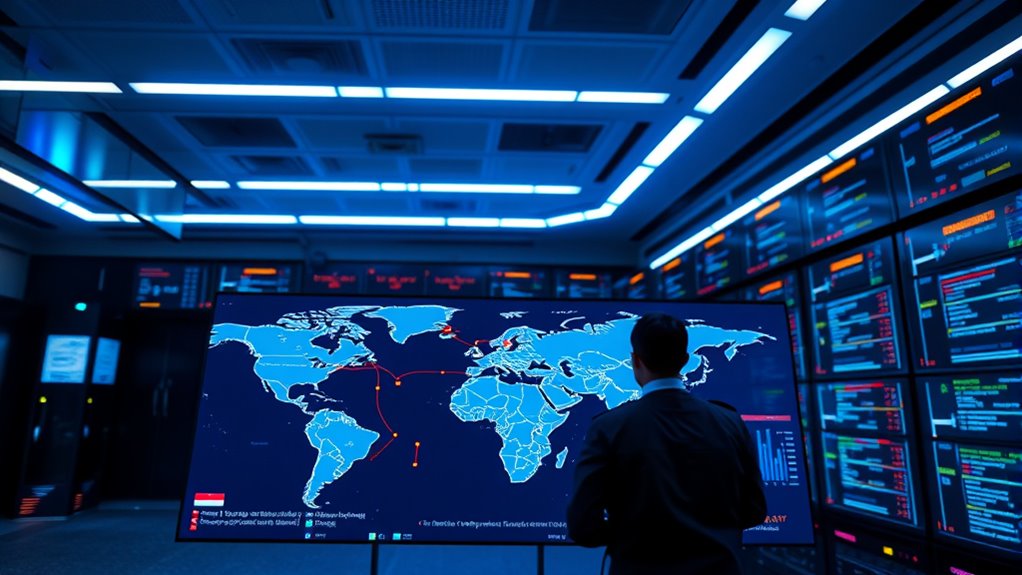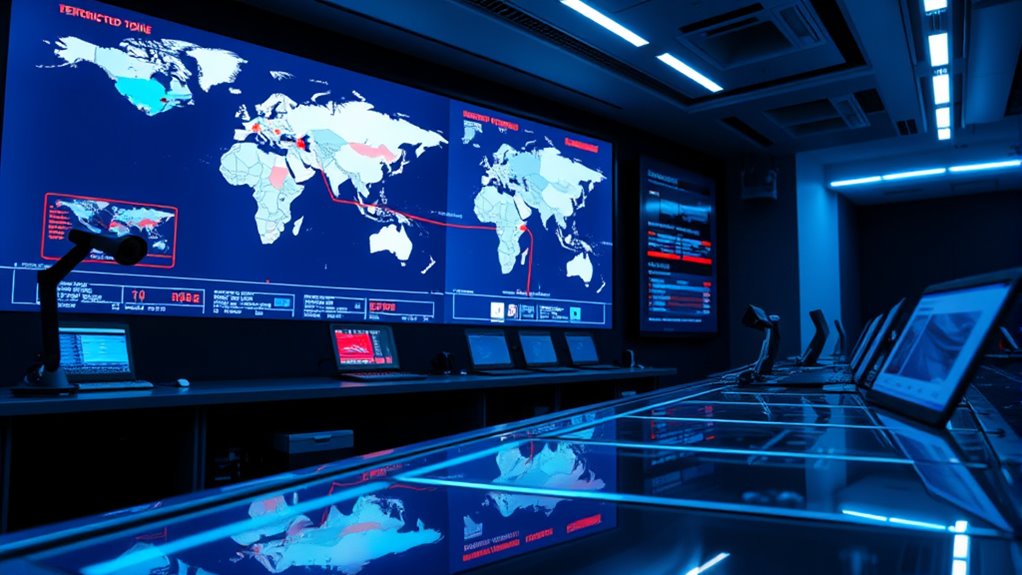The US uses export controls as a key strategy to curb China’s technological rise by restricting access to advanced technology like semiconductors, AI, and telecommunications. These controls aim to protect national security and maintain the US’s technological edge by limiting China’s ability to develop cutting-edge innovations. They involve international cooperation, continuous updates, and sophisticated monitoring, including AI-powered enforcement tools. If you want to understand how these mechanisms adapt to evolving threats, there’s more to explore.
Key Takeaways
- The US uses export controls to restrict China’s access to advanced technologies like semiconductors, AI, and telecommunications.
- These controls aim to slow China’s technological development and maintain US military and economic superiority.
- International cooperation ensures allies align policies and effectively block unauthorized technology transfers.
- AI-enabled monitoring enhances detection of violations and adapts controls to evolving technological vulnerabilities.
- Continuous policy updates and global collaboration are essential to counter emerging threats and safeguard national security.

Have you ever wondered what export controls are and why they matter? Essentially, export controls are government policies that regulate the transfer of certain goods, technologies, and information across borders. They’re designed to protect national security, promote foreign policy goals, and prevent sensitive technology from falling into the wrong hands. When it comes to the US and China, export controls have become a critical tool to curb China’s technological rise, especially in areas like semiconductors, artificial intelligence, and telecommunications. These restrictions aim to slow down China’s development of advanced tech that could threaten US interests or military superiority. But implementing these controls isn’t just about setting rules; it involves complex international cooperation, ensuring that allies and partners align their policies to create an effective barrier against the unauthorized transfer of sensitive technology. Continuous updates and adaptations are necessary because technological vulnerabilities evolve rapidly, requiring ongoing adjustments to export policies. Effective enforcement also depends on understanding and addressing global supply chains that can be complex and interconnected. Additionally, monitoring emerging technological threats is crucial for identifying new risks before they can be exploited by adversaries. Moreover, staying ahead of emerging technological threats is essential for maintaining a strategic edge in global competition. Enhanced export control mechanisms leveraging AI security technologies can improve the detection of unauthorized transfers and prevent violations more efficiently.
Frequently Asked Questions
How Do Export Controls Impact Global Supply Chains?
You’ll find that export controls, like technology restrictions, markedly impact global supply chains. When these restrictions tighten, they can cause supply chain disruptions, making it harder to get essential components and products across borders. This affects industries worldwide, as companies must navigate new regulations, delays, and shortages. Ultimately, export controls can slow innovation and increase costs, forcing you to adapt quickly to maintain your business operations amid these unpredictable global shifts.
Are There Exemptions for Certain Tech Exports to China?
Think of export controls like a gate with some secret passages. Yes, there are technology exemptions and licensing exemptions that let certain tech exports to China go through without strict restrictions. These exemptions are carefully defined, allowing some companies to continue trade while maintaining national security. You should check specific regulations, as exemptions vary depending on the product, destination, and purpose, ensuring important technologies aren’t completely cut off.
How Often Are Export Control Regulations Updated?
You might wonder how often export control updates happen, and regulation frequency varies based on national security needs and technological advances. The US regularly reviews and updates export controls to adapt to changing threats and innovation, often on an annual or semi-annual basis. Staying informed about these updates is essential, so monitor official government announcements to guarantee compliance and understand any new restrictions or exemptions affecting your tech exports to China.
What Are the Penalties for Violating Export Controls?
Did you know that violations of export controls can lead to fines up to $1 million and even criminal charges? Penalty enforcement is strict, emphasizing the importance of compliance measures. If you’re caught violating these rules, you could face hefty penalties, license denial, or jail time. Staying compliant helps you avoid legal trouble and supports national security efforts. Always double-check regulations to protect yourself and your business from severe consequences.
How Can Companies Ensure Compliance With Export Regulations?
To guarantee compliance with export regulations, you should implement robust compliance programs that include regular training on export laws and technology licensing requirements. Stay updated on regulations, maintain accurate records, and conduct internal audits. Collaborate with legal experts to understand restrictions on sensitive technologies and ensure all transactions adhere to export controls. This proactive approach helps you avoid penalties and supports responsible global trade practices.
Conclusion
Think of export controls like a carefully guarded garden, where you protect your most precious plants from invasive weeds. Just last year, the US blocked a Chinese company from accessing cutting-edge chip technology, preventing them from planting seeds of future innovation. These measures aim to keep American advancements safe while slowing China’s tech rise. By understanding these controls, you see how the US is tending its garden—carefully and strategically—to preserve its competitive edge.








